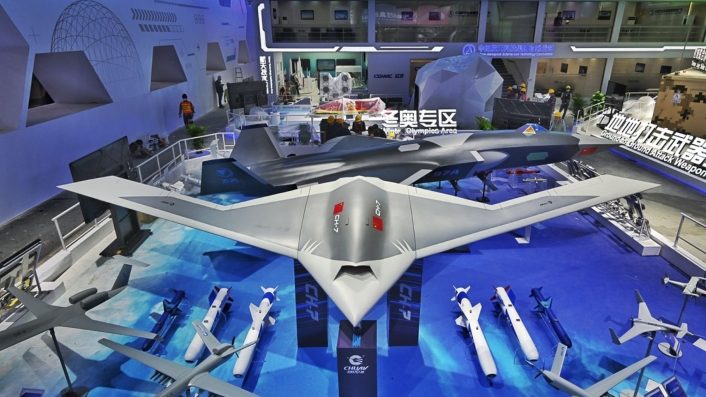
The new flying wing CH-7 UCAV features a mixed wing-fuselage airframe with a high level of stealth and long-range capabilities, reportedly aimed at continuous reconnaissance and monitoring in highly hazardous environments.
Images And videos have appeared online, showing China’s massive CH-7 UCAV on a runway during what appears to be a taxi test. The aircraft was first unveiled in 2018 and later underwent several design changes, according to what Chinese reports described.
The final live model is shown in a yellow factory primer paintalthough it is not clear whether it is a prototype or a pre-series production aircraft. The circling 360-degree video provides a view of the tailless design from all angles.
In February 2024, Global times reported that the CH-7 stealth UCAV (some reports also call it the Rainbow 7 or Cai Hong-7) has completed testing and the development phase is expected to end in 2024. Observers also expected the CH-7 to appear at the fair. Zhuhai air show 2024 this week.
The first version of the drone was unveiled at the 2018 Zhuhai Airshow, and a newer version was shown in the 2022 episode. Developed by CASC (China Aerospace Science and Technology Corporation), the CH-7 is powered by a single turbofan engine with a top-mounted air intake, and is intended for high-altitude, deep-penetration missions.
CH-7 Stealth Drone. pic.twitter.com/zlV26UxzHc
— International Defense Analysis (@Defence_IDA) November 8, 2024
The UCAV flying wing has a clearly visible mixed wing body airframe which represents “a high level of stealth and long-range capability “aimed at 24-hour reconnaissance and monitoring in highly hazardous environments,” according to Chinese reports. The CH-7 can “continue to detect enemy targets for a long time,” Shi Wen, the chief engineer of the CH series of drones, told Global times at Airshow China in 2022.
The striking resemblance to one of the first renderings of the still-secret Northrop Grumman RQ-180 stealth UAS (Unmanned Aerial System), which made the front page of Aviation Week in 2013, is also clearly visible.
Just feel like it pic.twitter.com/f9EWmP3y0x
— Bill Sweetman (@ValkStrategy) November 8, 2024
Changes from the previous displays
A 2022 exhibition scale model of the CH-7 was shown with three different types of air-to-ground munitions, two of which appeared to be equipped with optical viewfinders. The UCAV has likely undergone changes since then, as there are some observable differences between the 2022 scale model and the new overhead view photo of the live airframe on the runway.
The curved kite wing UCAV has a flat exhaust and what could be sensors on the intake nacelles, possibly intended as antennas for receiving SATNAV (satellite navigation) signals, network information exchange and bi-directional transceivers for data linking.
The tests on the modified prototype “verified the aircraft’s excellent performance and the effectiveness of the aircraft’s airframe and structural design,” the report said Global times. This means that the UCAV has flown before. The developers received “new designs to further improve the effectiveness of information-based combat in modern warfare.”
 Prototype of the most advanced CH-7 stealth UAV in the exhibition hall of the Airshow China 2022. Credit: Global Times/Tao Ran, CASC
Prototype of the most advanced CH-7 stealth UAV in the exhibition hall of the Airshow China 2022. Credit: Global Times/Tao Ran, CASC
Global times also provided some specifications, stating that the CH-7 has a wingspan of 26 meters, four meters longer than the original version, and a service ceiling of 15 kilometers, higher than the original version’s 10-13 kilometers.
With a maximum takeoff weight of 10 tons, the CH-7 can also carry large missiles or send other weapons to hit high-value enemy targets. Other to inform on X said it could have a maximum speed of 926 km/h and an endurance of 15 hours.
The absence of vertical stabilizers improves stealth functionsespecially from the side, as there are no flat surfaces for the electromagnetic emissions to reflect off of. The aerodynamically smooth design suggests it has been optimized to maximize airflow performance, with a strong flight control computer and stability enhancement software.
The use of the CH-7 and the mysterious drone
Overall, one could say that the multitude of UAVs and UCAVs in the Chinese inventory, including the WZ-7, WZ-10, the GJ-11 sharp sword and the CH-9 UCAV represents an argument about possessing both redundancy and attritability.
The unmanned systems that perform reconnaissance, ELINT/EW and attack missions are highly vulnerable to Allied anti-aircraft fire, but they also reduce operational costs and human casualties, while also threatening to pinpoint enemy positions if deployed.
Actual CH-7pic.twitter.com/6IMDewi8mP
— Húrin (@Hurin92) November 8, 2024
What underpins China’s unmanned doctrine is its industrial capability to have all supply chains in the country aerospace components and electronics, unlike the US, which only started reindustrializing and domesticating its production two years ago.
Since the time it first appeared in 2018, the UCAV has closely resembled the Northrop Grumman At Airshow China 2022, the wing flaps were redesigned.
However, the CH-7 only shares some similarities with the mysterious UCAV test model The aviator which was reported in August, as the latest image shows the canted wing parts being longer. The sweep angle and overall proportions are also different, and satellite images from the radar test facility show possible tilted vertical stabilizers toward the trailing edge.
What relationship the CH-7 has to this model is not clear, but it would not be far-fetched to assume that the data generated from the radar reflectivity tests informed some of the development of the CH-7.